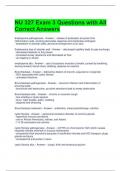NU 327 Exam 3 Questions with All
Correct Answers
Emphysema pathogenesis - Answer- - release of proteolytic enzymes from
inflammatory cells, smoking stimulates response and inactivates antitrypsin
- breakdown of alveolar walls, abnormal enlargement of air sacs
Emphysema loss of alveolar wall - Answer- - decreased capillary beds for gas exchange
- decreased elasticity of lung tissue
- increased airway resistance and decreased air flow
- air trapping in alveoli
emphysema s&s - Answer- - use of accessory muscles to breath, pursed lip breathing,
leaning forward, barrel chest, clubbing, dyspnea on exertion
Bronchiectasis - Answer- - defined by dilation of bronchi, acquired on congenital
- 50% associated with cystic fibrosis
- untreated infections
Bronchiectasis pathogenesis - Answer- - recurrent infection and inflammation of
bronchial walls
- bronchiole wall destruction, purulent secretions lead to airway obstruction
Bronchiectasis s&s: - Answer- - chronic or recurrent cough
- foul smelling or green sputum
- fever, night sweats, pallor, clubbing
- dyspnea and wheezing
Bronchiectasis treatment - Answer- - antibiotics, chest physiotherapy, nutrition
cystic fibrosis - Answer- - autosomal recessive disorder of exocrine glands
- hyperthick mucous secretions
- rare in African Americans, natives, and Asians
- 1 in 25 caucasians are carriers
cystic fibrosis pathogenesis - Answer- - (CFTR) on chromosome 7q31 which causes
impaired chloride channels in mucous membranes
- excessively thick secretions because of insufficient chloride and H2O transport, plugs
glands and ducts
- increased fat and protein in stool
cystic fibrosis s&s: - Answer- - cough, thick and tenacious sputum
, - bronchitis, failure to thrive
- pallor, right sided heart failure (cor pulmonale)
- clubbing (late), dyspnea, tachypnea, sternum retractions
- hyper resonance, adventitious lung sounds
- growth weight m, head circumference, weight
cystic fibrosis treatment - Answer- - high protein diet
- ADEK vitamin supplements
- replacement of pancreatic enzymes
Interstitial lung disease - Answer- - group of disorders characterized by infiltration of
alveolar walls by cells fluid and connective tissue (acute, sub acute, and chronic)
diffuse interstitial lung disease - Answer- - defined by thickened alveolar interstitium
(fibrosis)
interstitial lung disease pathogenesis - Answer- - not well understood but thought to be
inflammatory response to injury
- inflammation, fibrosis, destruction
- honeycomb appearance on CXR
interstitial lung disease s&s: - Answer- - progressive dyspnea, non productive cough
- tachypnea, crackles, cyanosis, anorexia
interstitial lung disease diagnosis: - Answer- pulmonary function test or honeycomb
CXR
interstitial lung disease treatment - Answer- - remove triggers (smoking)
- immunosuppressive therapy
- steroids, lung transplant
acute respiratory distress syndrome - Answer- - defined by damage to alveolar capillary
membrane
- 20-90% mortality
- hypoxemia refractory to increasing levels of O2
- associated with trauma, shock, sepsis, aspiration of gastric acid, fat emboli
ARDS - Answer- •Assault to the pulmonary system
•Respiratory distress
•Decreased lung compliance
•Severe respiratory failure
ARDS pathogenesis - Answer- - widespread inflammation leading to: pulmonary edema
(leaky capillaries), atelectasis (complete or partial lung collapse), decreased surfactant,
fibrosis (inflammatory disposition of proteins, lungs stiffen)
- stiff and noncomplient lungs




